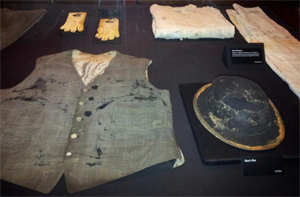At the Fort Worth Museum of Science and History, a new exhibition, “Titanic: the Artifact Exhibition” honors the centennial anniversary of the fabled and fated “unsinkable” luxury liner. But the exhibition doesn’t just show you artifacts or present information; it helps you relive it.
Upon “boarding” the “ship,” guests receive a boarding pass with the name of an actual passenger of the ship. After navigating the exhibit, which recreates the experiences of the passengers from first class to third class, you get to find out if you lived or died.

During my journey, I was given the identity of Dorothy Gibson, an American silent film actress, model, and singer. Assuming her identity certainly induced an eerie feeling. When Gibson boarded the Titanic with her mother, she was 22. I happen to be 22.
A picture of Gibson and other First Class dignitaries are on display as well as pieces of their jewelry, the types of dishes they ate from, and a recreated First Class cabin.
The beginning of the exhibit creates warm and joyful feelings. You can feel the excitement and grandeur associated with the completed construction of the world’s largest vessel at the time. The Titanic conveyed status. Some of the most wealthy and beloved people of the early 20th century were aboard the ship. And though you see as you walk the exhibit that the Second and Third class boarders were not afforded the luxury amenities available to First Class, you realize it was truly a ship of dreams. There were people aboard living dream lives and others vying for their shot at the American dream. Moving through this part of the exhibition, it is hard not to be inspired.

The inspiration slowly transforms into fear and desperation once you pass the cabins and descend into the boiler rooms. On the wall, there are quotes from workers on the ship that incite a rush of adrenaline as you realize that you are approaching the end of the world’s “unsinkable” ship and the demise of many. After learning that the ship’s two lookouts misplaced their binoculars, an unfortunate reality that might have saved the ship and its passengers, I began to look for the news of the iceberg. I didn’t need to look for news, I saw the iceberg… Well, I saw a silhouette of the iceberg.
Creative director of “Titanic: the Artifact Exhibit,” Mark Lach said, “You can reach out and touch it and feel that it’s cold. It gives you an idea of just how cold those Atlantic waters are.”

I touched the iceberg and it was definitely cold, and I was reminded that many who died at the sinking of the Titanic died from hypothermia. As I neared the end of the exhibit and finally saw a large board with the passengers separated by class and categorized by the simple and chilling words: “survived” and “lost.”
I looked for Dorothy Gibson’s name, and was surprised to discover that she survived. Many were not as fortunate as she. There were 2,228 passengers and crew on the Titanic and only 705 survived.
Even though you all have surely heard the name, “Titanic” and have some knowledge of the extremely long James Cameron film, nothing prepares you for coming face to face with history you can see, feel, and hear.
“You will connect with it [the exhibit] in a way that will surprise you,” said Van Romans, museum president. He’s right.





